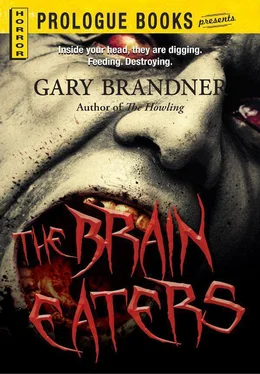In Seattle there had been a number of violent occurrences. The people involved were, for the most part, from respected backgrounds. A particularly grisly story involved an administrator of the University of Washington and his wife who apparently killed each other with their bare hands in their own living room.
Milwaukee was hard hit, especially in the neighborhood around Vic’s Tavern. Although none of the stories assumed a connection, several pointed out that among those who had freaked out the previous night were a number of people who had been present when Hank Stransky died.
Some of the names Corey recognized. They were men he had laughed with, drunk beer with, and argued sports with. Two of them had bowled on the tavern team. One had gone to pieces while digging in the garden and had attacked neighbors with a shovel. The other had started screaming suddenly at the dinner table. While his horrified family watched, he picked up his two-year-old daughter and threw her against the wall. The man was being held in the violent ward of the Milwaukee county jail. The little girl was in critical condition, with possible brain damage.
“Damn, damn, damn!” Corey said under his breath.
“Pretty bad,” Doc Ingersoll agreed.
Corey rose and started for the city room. “I’ve got to get busy.”
Doc Ingersoll glanced down at the scattered wire copy. “Somebody you know?”
“What? Oh, yeah, slightly.”
“Sorry,” Doc said. “You going out to see them?”
“Later,” Corey said. “I’ve got to get on the phone now.”
Ingersoll took a deep drag and coughed for several seconds. “I presume you’re not calling to comfort the widows and orphans.”
Corey threw a look back over his shoulder. “You want to be Mother Teresa, you go ahead. I’m a working reporter, and this is a story, Doc. This is a capital-S story, and it’s right in my lap.”
The older reporter watched through a curtain of smoke from his smoldering butt as Corey hurried out.
• • •
At his desk in the city room, Corey matched the names of the victims that were mentioned in the wire stories against the telephone book and came up with a list of numbers. He also noted the names of the hospitals where they were taken and added the police and any government agency he thought might be involved. When he was through, he had a pageful of telephone numbers.
He started with the families and friends of the victims. Few of them were willing to talk to the press, but those who were told chillingly similar stories. The victims had shown no abnormal traits in the past. They were usually healthy and in the prime of life. Only during the past week had they displayed any symptoms of illness. Those included a rash or mild infection of some sore on the skin, a brief flulike period of low fever and aching joints, and finally the headache.
Corey scribbled rapid notes as he talked, coaxing answers out of bewildered, grief-stricken people. All part of the job, he reminded himself. At least he wasn’t jamming a microphone into their faces.
When he came to a break in his list, he dashed back to the wire room for late input and took a few minutes to plot the reported cases on a map of the United States. It was clear that the attacks were clustered around three population centers — Milwaukee, New York, and Seattle. There were stories of scattered incidents in other parts of the country, including the wild man on the airliner. That one, however, could be counted as New York, since that was the originating point of the flight.
Next Corey went after the hospitals. From them he got little information. Victims who were not killed during their violent seizure had to be put under restraints. No, the patients were not in any condition to be interviewed. No, the hospital authorities were not prepared to offer any theories on what had happened to the people. No, they did not want to talk to him later.
Probably waiting until a camera crew showed up so they could be on television, Corey thought irritably.
Without much hope, he went on to the last batch of numbers on his list — the various governmental health agencies. He got only brusque negatives from the city, county, and state. Finally, he was put through to a U.S. assistant secretary of Health and Human Services in Washington.
“Yes, I’ve heard the reports,” the assistant secretary told Corey when the connection was finally made.
“I’d like your comment,” Corey said.
“I don’t see that there’s anything to comment on at this point in time.”
“We are talking about the same thing, aren’t we? The sudden violent attacks on people here in Milwaukee and on both coasts?”
“Well, now, we’re not convinced that there is anything statistically abnormal in the situation.”
“I have the reports right here in front of me,” Corey said, fighting to control his rising irritation. “There are at least twenty reported cases so far, and more coming in every hour.”
“Twenty hardly seems to be excessive. Over any given twenty-four-hour period I can show you figures that would suggest a raging epidemic of anything from measles to bone cancer.”
“We’re not talking measles here,” Corey said. “We’re talking about perfectly healthy people who suddenly go crazy. Do you know how many dead there are?”
“I’ve heard reports. Unconfirmed, I hasten to add.”
“You said epidemic a minute ago. Are you willing to call this an epidemic?”
“Nothing of the sort,” the assistant secretary said quickly. “I was merely using the analogy to make my point.”
“Which is?”
“That the data we have is insufficient basis for any conclusions.”
“At this point in time,” Corey said sarcastically.
“Exactly,” said the assistant secretary, missing the inflection.
“How many of these violent seizures will it take before the government admits that something unusual is happening?”
“That’s a speculative question that I can hardly be expected to answer.”
“Then the Department of Health and Human Services has an official ‘no comment’?”
“I have not been appointed spokesperson for the department.”
“My call was put through to you.”
“I happened to be in my office when your call came in. My field is personnel administration.”
“All right, no official quotes. Do you have any private theories?
“I can think of one possibility. Mass hysteria.”
“You’re not serious.”
“Of course I’m serious. Do you remember a couple of years ago when we had the big AIDS panic?”
“As I recall, quite a few of those people who thought they had AIDS really did,” Corey said.
“My point is that a whole lot more people did not. Here we have a few isolated cases of aberrant behavior in scattered sections of the country. You people of the media scramble to report them, and immediately healthy individuals everywhere start feeling the symptoms. It’s called the medical students’ syndrome. Show them an exotic set of symptoms and immediately a good percentage will start suffering them. Mass hypochondria, if you like.”
“Is that for publication?”
“Absolutely not,” The suave tone of the assistant secretary wavered. “You asked me for a private opinion, and that’s it. As far as the Department of Health and Human Services is concerned, the situation has not officially been brought to our attention.”
“Goddamit, that’s what I’m trying to do,” Corey yelled into the phone. “If you’re not going to talk to me, then put on somebody who will.”
“I’ll give you back to the switchboard,” said the assistant secretary. “They’ll connect you with our chief of public relations.”
“Shit!” Corey banged the telephone back into the cradle and sat glaring at it like some loathsome animal.
Читать дальше












